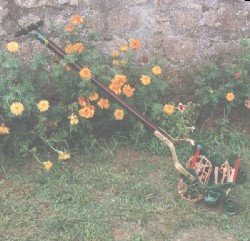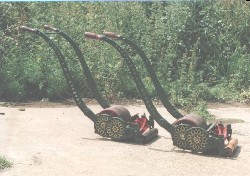History of the Lawnmower:
Part Three: 1870s-1890s
The year 1870 saw the first influx of American manufactured machines to the British market. The one machine that created the largest impact was the Archimedean, so named as the cutting cylinder worked on the Archimedean screw principle. It was said that the machine could even be worked in wet conditions, there being two skids at the front replacing the roller. By 1878 the design had altered and the Archimedean had gained two front wheels. Towards the end of the 1870s numbers of different makes of lawn mowers were being imported from America.

On the whole these machines appeared cheaper and were of a lot lighter in construction. Most of the designs favoured the Follows and Bates Climax
One reason for this was that in American the grass grew more openly, similar to rye. These American machines became great favourites with the ironmongery trade.
Later, in the late 1880s, if an ironmonger ordered a large enough quantity he could have name cast
in as an advertisement, hence a new trade was formed. The name given to this type of machine was a
catalogue. The main companies involved in this trade were E C Stearns of Syracuse, White and Bateman and Milburns.
John Post Lawrence was a young businessman, while visiting the Chicago World Fair of 1878 was introduced to Lloyd, Suplee and Walton, makers of the Pennsylvania lawn mower. On his return to this country he set up an agency in London named Lloyd, Lawrence & Co. The design was on the same principle as the Climax except that a further gear was placed between the land wheel and the gear on the end of the cutting cylinder shaft, allowing the operator to push the mower with greater ease. The design was to prove
so good that other companies copied it and Lloyd went from strength to strength. Today they still hold the record for the machine longest in production. In the 1880s Thomas Green introduced a range of mowers designed for small plots. Called the Multum in Parvo which, translated from Latin, means
'with little, much', Shanks were also to follow the American design with a machine called the Yankee. It was about this time that Shanks, Green and Ransomes started to export their mowers, with many being sold to countries in the British Empire. Both Shanks and Ransomes were to achieve a foothold in Australia and New Zealand, the latter being a particularly good market, having a climate relative to our own.

With the advancements of sport in the 1880s more companies were becoming involved in the manufacture of grass cutting machinery. A few of the more notable names were Crowley of Sheffield with their Invincible range, Samuelson with the Favourite, Hartley Sugden of Halifax with a range of pony mowers called Windsor, Atlas and Balmoral. B Hurst & Sons, (better known for the production of children's playground equipment) also sold a small gear driven machine.
Towards the end of the 1890s more sports were developing, all requiring a better playing turf which, in turn, put pressure on to produce better machines. By this time Ransomes were into the science of turf cutting and in 1897 came up with two new
ideas. The first was ribbing on the land roller to stop the mower slipping when moving along banks. The second, a double angled cutting cylinder, sometimes called a split cutting cylinder. It was noticed that, on a normal cylinder, the grass tended to be thrown to one side of the collecting box so this double angle method directed the grass to the centre of the box. A drawback to this innovation, however, meant that uneven wear would occur on the centre of the bottom blade.
In the latter part of 1893 a new form of motive power was added to the lawn mower, namely steam, the inventor of the first steam lawn mower being one James Sumner of Leyland, Lancashire. His machine created a lot of attention. Fired by paraffin under pressure, it was said that the engine could be raised to working
pressure in ten minutes. The machine came in three sizes, 25in, 30in and 36in. A water tank was slung under the handle arms so the weight was all balanced on the rear roller which helped when turning. The Sumner engine was also sold as an adaptation to owners of horse drawn mowers. The first trials of steam mowing were held at Lords Cricket Ground in London.
One of the selling points of the steam mower was that you did not have to wait for the coachman to return before mowing could begin.
PART 2 or PART 4

